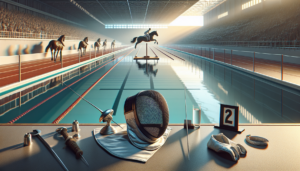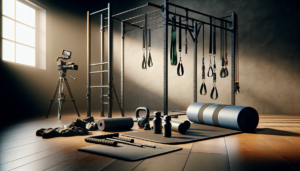Introduction to Heptathlon
The heptathlon is a grueling and exciting combined event in athletics that tests the athleticism, versatility, and endurance of female competitors across seven different track and field disciplines. Held over two days, the heptathlon pushes athletes to their limits as they strive for points in each event to emerge victorious overall. The heptathlon has a rich history dating back to the early 20th century and has been a part of the Olympic Games since 1984.
What is Heptathlon?
The heptathlon consists of seven events: the 100-meter hurdles, high jump, shot put, and 200-meter run on the first day; and the long jump, javelin throw, and 800-meter run on the second day. Athletes earn points in each event based on their performances, with the goal of accumulating the highest total score. The diverse range of events demands speed, power, agility, and stamina from competitors.
Brief History of Heptathlon
The origins of the heptathlon date back to the early 1980s, when it replaced the pentathlon as the main women’s combined event in athletics. The first heptathlon competition took place at the 1984 Los Angeles Olympics, where American athlete Jackie Joyner-Kersee won the inaugural gold medal. Joyner-Kersee went on to dominate the event, setting the still-standing world record of 7,291 points at the 1988 Seoul Olympics. The heptathlon has since become a flagship event in women’s athletics.
Heptathlon Events
Overview of Heptathlon Events
The seven events of the heptathlon test a wide array of athletic skills:
| Day 1 | Day 2 |
|---|---|
| 100-meter hurdles | Long jump |
| High jump | Javelin throw |
| Shot put | 800-meter run |
| 200-meter run |
Each event has its own rules and techniques that athletes must master to excel. The variety of events makes the heptathlon a captivating spectacle for fans.
Track Events in Heptathlon
The track events in the heptathlon include:
- 100-meter hurdles – A sprint over ten 83.8cm high hurdles
- 200-meter run – A half-lap sprint around the track
- 800-meter run – A two-lap, tactical middle distance race
Heptathletes need a combination of explosive speed, efficient hurdling technique, and smart pacing strategies to perform well in these events.
Field Events in Heptathlon
The field events of the heptathlon are:
- High jump – Athletes attempt to clear a 4-meter high bar
- Long jump – A running jump into a sand pit for distance
- Shot put – Launching a 4kg metal ball as far as possible
- Javelin throw – Hurling a 600g spear for distance down a runway
These events require power, agility, technical precision, and mental toughness from the competitors. Training for the diverse demands of the heptathlon field events is a significant challenge.
Scoring in Heptathlon
How Scoring Works in Heptathlon
In the heptathlon, athletes earn points for their performances in each event according to a standardized scoring table. The tables are based on statistical analysis of results in each event, allocating more points the better an athlete performs in relation to the world record. For example, a time of 13.85 seconds in the 100m hurdles scores 1000 points.
Points System in Heptathlon
The heptathlon uses a proportional points system, meaning that performances further away from the average result in that event receive disproportionately more or fewer points. This rewards exceptional performances and helps differentiate the top athletes.
For instance, the current world record in the heptathlon, set by Jackie Joyner-Kersee in 1988, stands at an incredible 7,291 points. Meanwhile, a score over 6,200 points is considered world class. At the 2016 Rio Olympics, gold medalist Nafissatou Thiam won with 6,810 points.
Famous Heptathlon Athletes
Top Heptathlon Athletes in History
Some of the most accomplished heptathletes in history include:
- Jackie Joyner-Kersee (USA) – Three-time Olympic gold medalist and world record holder with 7,291 points
- Carolina Klüft (SWE) – Olympic and three-time world champion in the 2000s
- Jessica Ennis-Hill (GBR) – Olympic gold and three world titles, including a triumphant win in London 2012
- Nafissatou Thiam (BEL) – Two-time reigning Olympic champion from Rio 2016 and Tokyo 2020
These women raised the bar for the event with their skill, consistency, and fierce competitiveness under pressure.
Current Leading Heptathlon Athletes
The world’s best heptathletes heading into the Paris 2024 Olympics are:
- Nafissatou Thiam (BEL) – Defending champion looking for a historic “three-peat”
- Anouk Vetter (NED) – Silver medalist in Tokyo 2020 and 2022 world champion
- Anna Hall (USA) – Rising star who won world bronze in 2022 at just 21 years old
- Katarina Johnson-Thompson (GBR) – 2019 world champion looking to bounce back from injuries
With this exciting crop of talented athletes, the women’s heptathlon in Paris should be a riveting battle from start to finish.
Training for Heptathlon
Training Regimen for Heptathlon
Training to be a world-class heptathlete is a monumental undertaking that requires immense discipline, planning, and hours of practice. Athletes must meticulously hone their technique in all seven diverse events while also building the stamina to hold up through two days of intense competition.
A typical training week for an elite heptathlete might include:
- Sprint workouts and plyometrics to train explosive power
- Technical practice for jumping and throwing events
- Endurance runs and tempo sessions to build a strong aerobic base
- Weights and resistance exercises to develop full-body strength
- Recovery sessions like yoga, massage, and physical therapy
Balancing event-specific work with general conditioning is key to excelling across the heptathlon’s diverse challenges. Many heptathletes also work closely with a sports psychologist to hone their mental game.
Techniques and Tips for Heptathlon
While mastering all seven events is a lifetime pursuit, here are some key techniques and tips for heptathletes:
- Maintain a tight, efficient arm swing while sprinting and hurdling
- Attack hurdles aggressively, snapping the lead leg down quickly
- Use a consistent, repeatable approach in the jumps for better accuracy
- Throw the shot and javelin with the whole body, not just the arm
- Pace the 800m evenly with a strong kick over the final 200m
Of course, the best way to improve is through diligent practice under the guidance of an experienced multi-events coach who can provide technical feedback and help optimize training.
Heptathlon Competitions and Records
Major Heptathlon Competitions
The biggest stages for the women’s heptathlon are:
- The Olympic Games – Held every four years as the sport’s ultimate prize
- The World Athletics Championships – Biennial event featuring the world’s best
- The Hypo-Meeting in Götzis, Austria – The top annual heptathlon-only competition
- The Commonwealth Games and continental championships like the European Championships
Winning a title at one of these prestigious meets cements an athlete’s status among the heptathlon’s all-time greats.
World Records in Heptathlon
The current world records in the women’s heptathlon are:
- Overall record: 7,291 points – Jackie Joyner-Kersee (USA), 1988 Olympics in Seoul
- 100m hurdles: 12.69 sec – Jackie Joyner-Kersee (USA), 1988 Olympics in Seoul
- High jump: 1.97 m – Nafissatou Thiam (BEL), 2017 Hypo-Meeting
- Shot put: 17.29 m – Natalya Sazanovich (BLR), 2004 Olympics in Athens
- 200m: 22.30 sec – Dafne Schippers (NED), 2017 World Championships in London
- Long jump: 7.27 m – Jackie Joyner-Kersee (USA), 1988 Olympics in Seoul
- Javelin: 57.76m – Nafissatou Thiam (BEL), 2022 Diamond League in Brussels
- 800m: 2:02.98 – Anke Vater-Behmer (GER), 2001 World Championships in Edmonton
Jackie Joyner-Kersee’s longstanding world record is considered one of the most exceptional feats in athletics, showcasing her remarkable dominance. In recent years, Nafissatou Thiam has come the closest to challenging it.
Heptathlon Equipment
Essential Equipment for Heptathlon
To train and compete in the heptathlon, athletes require an array of specialized equipment, including:
- Running spikes for sprints, hurdles, and jumps
- Throwing shoes with a grippy, supportive sole
- Racing hurdles for practice
- High jump and pole vault landing mats
- Long jump take-off boards and sand pits
- Shot puts in the women’s 4kg weight
- Regulation 600g javelins
Having reliable, high-quality equipment is essential for both safety and peak performance.
Choosing the Right Gear for Heptathlon
With so many event-specific demands, heptathletes must be discerning in selecting their gear and equipment. Key considerations include:
- Spikes: Lightweight with the right amount of traction and support for each event
- Clothing: Breathable, nonrestrictive, and compliant with competition regulations
- Implements: Matched to the athlete’s size and technique (e.g., shot put grip size)
- Training tools: Items like stretch bands and foam rollers aid event-specific training
Many elite heptathletes work closely with equipment manufacturers to customize gear to their specific needs and preferences. The right equipment allows an athlete to focus fully on executing their event skills.
In conclusion, the heptathlon is a compelling test of versatility and toughness that demands the utmost commitment from athletes. At the Paris 2024 Olympics, the women’s heptathlon is poised to be a must-watch event as the world’s greatest all-around athletes push themselves to the limit in pursuit of gold and glory.





